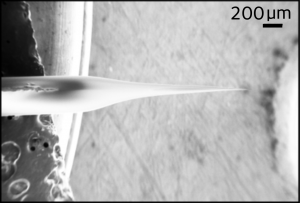Resistive pulse sensing with nanopores is a versatile single molecule sensing technique, withapplications ranging from DNA sequencing to digital data storage. The basic operating premise is to analyse transient changes in the ionic current driven through a nanoscale pore as macromolecules such as DNA move through it. As such, dynamic signatures and fluctuations of an ionic current contain significant information.
 Our aim is to develop approaches to decode this information to achieve a fundamental understanding of transport in these nanoscale systems and engineer methods to improve their sensing characteristics. For example, we have recently shown that adding an adsorbing polymer to the system introduces non-trivial noise characteristics, which when carefully analysed yield information on underlying adsorption potentials. In the future, we intend to functionalise nanopores with DNA origami, allowing us to achieve unprecedented control over nanoscale transport processes.
Our aim is to develop approaches to decode this information to achieve a fundamental understanding of transport in these nanoscale systems and engineer methods to improve their sensing characteristics. For example, we have recently shown that adding an adsorbing polymer to the system introduces non-trivial noise characteristics, which when carefully analysed yield information on underlying adsorption potentials. In the future, we intend to functionalise nanopores with DNA origami, allowing us to achieve unprecedented control over nanoscale transport processes.
Key publication:
Stuart F. Knowles, Nicole E. Weckman, Vincent J. Lim, Douwe J. Bonthuis, Ulrich F. Keyser and Alice L. Thorneywork, ‘Current fluctuations in nanopores reveal the polymer wall adsorption potential’ Phys. Rev. Lett, 127, 137801, (2021) arXiv:2012.00884,
Stuart F. Knowles, Ulrich F. Keyser and Alice L. Thorneywork, ‘Noise properties of rectifying and non-rectifying nanopores’, Nanotechnology, 31 (10), 10LT01 (2019)